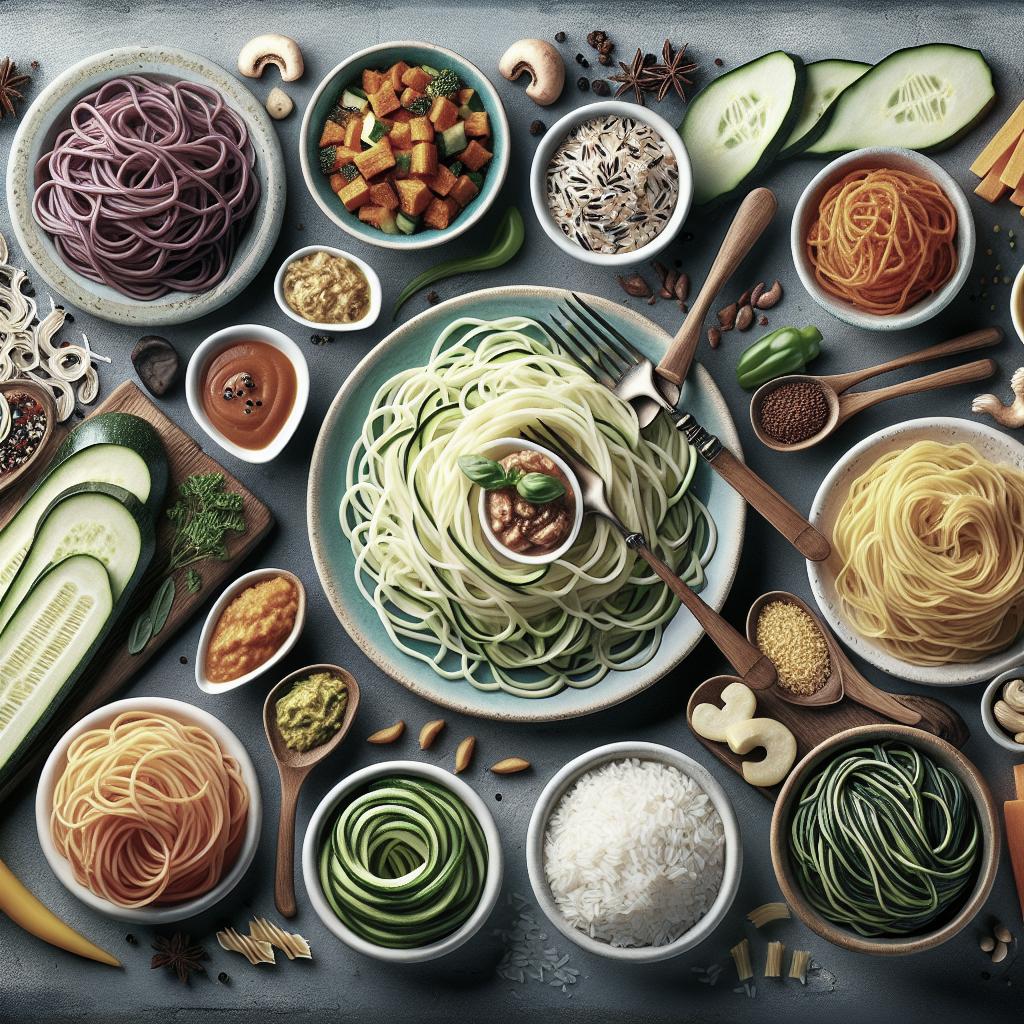“`html
Pasta Alternatives for Your Next Meal
For many, pasta is a staple in their diet—versatile, comforting, and a blank canvas for numerous sauces and flavors. Yet, whether you’re looking to cut back on gluten, reduce carbs, or simply experiment with new tastes, pasta alternatives can elevate your dishes in fresh and exciting ways. This blog post delves into the varieties that have caught our attention, tested from their cost-efficiency to nutritional advantages. We’ll walk you through feedback from Healthline’s evaluations, explore a comprehensive review of each alternative, and guide you in choosing the best option for your culinary needs. Whether spirals, penne, or spaghetti are your shape of choice, we’ve uncovered substitutes that embrace both texture and taste. Join us as we explore this vibrant world of pasta alternatives.
A quick look at the types of pasta alternatives we tasted
As more options flood the market, it’s essential to understand what each alternative offers both nutritionally and in terms of flavor. We embarked on a taste test journey exploring several plant-based and grain-free alternatives that have made significant impressions on pasta lovers. From high-protein legumes to nutrient-rich roots, these pasta alternatives bring unique textures and flavors that stand out from traditional wheat-based pasta.
Each type presents its unique culinary characteristics. Whether you are prioritizing a health-conscious diet, exploring gluten-free options, or simply want variety in your pasta experience, this guide will address your preferences through in-depth analysis and firsthand taste experiences.
Price guide
Finding the right pasta alternative involves balancing quality and cost-effectiveness. While some options are priced similarly to traditional pasta, others may come at a premium. Factors such as organic certification, brand recognition, and base ingredient impact prices significantly.
Here, we lay out a price guide comparing these pasta alternatives to keep you informed as you make shopping decisions. This includes where they can be purchased and if opting for an alternative fits within your budgetary constraints.
Healthline’s feedback on pasta alternatives
Turning to expert opinion is crucial when evaluating health benefits. Healthline has provided insightful feedback on nutritional profiles relating to vitamins, minerals, and calorie content. Their studies highlight how these pasta alternatives can complement specific dietary goals, such as increasing fiber intake or upping plant-based protein.
Importantly, Healthline’s insights reinforce which pasta alternatives align best with dietary restrictions or targeted nutrition plans, adding an additional layer of understanding to our taste tests and recommendations.
Now Foods Organic Quinoa Spaghetti
Pros
The Now Foods Organic Quinoa Spaghetti offers several advantages, including a robust nutritional profile rich in protein and essential amino acids. Its nutty flavor pairs wonderfully with earthy sauces, offering a texture similar to al dente traditional pasta.
Cons
Unfortunately, quinoa spaghetti’s unique flavor may not appeal to everyone. Those accustomed to neutral-tasting pasta might find the taste overpowering. Additionally, it tends to hold moisture, which affects texture if not cooked precisely.
Trader Joe’s Hearts of Palm Pasta
Pros
Known for its lightness and low-calorie count, Trader Joe’s Hearts of Palm Pasta is perfect for those seeking a weight-control-friendly dish. It replicates the texture and look of traditional pasta, making it a visually appealing substitute.
Cons
However, its mild taste requires bold sauces to boost flavor, which could limit culinary creativity. It’s also priced higher than average pasta alternatives, making it less accessible for budget-conscious shoppers.
Banza Chickpea Spaghetti
Pros
Banza Chickpea Spaghetti boasts an impressive protein and fiber content, making it a powerhouse for nutrient-dense meals. Its firm texture holds up well under sauces, providing a satisfying bite similar to traditional spaghetti.
Cons
On the flip side, chickpea pasta can present a slightly grainy texture. Additionally, it often carries a premium price tag, which can be a deterrent for some.
Jovial Organic Brown Rice Penne
Pros
Jovial Organic Brown Rice Penne is known for its gluten-free certification and smooth texture that mimics traditional penne. It’s the go-to choice for those sensitive to gluten but not wanting to compromise on texture.
Cons
Despite its strengths, brown rice penne can become sticky if overcooked. Also, some find its flavor surprisingly close to rice, which may not align with all palate expectations.
Trader Joe’s Brown Rice and Quinoa Fusilli Pasta
Pros
A delightful blend of two grains, Trader Joe’s Brown Rice and Quinoa Fusilli offers added nutritional benefits such as magnesium and iron. The fusilli shape catches hearty sauces well, enhancing the eating experience.
Cons
This pasta can be slightly chewy, which might not suit everyone. Another downside is that recipes demanding a firmer texture might require adjustments in cooking time.
Veggiecraft Zucchini Penne
Pros
Veggiecraft Zucchini Penne is low-calorie and provides an impressive veggie serving through pasta. Its subtle flavor serves as an excellent base for bright and zingy sauces without overwhelming other ingredients.
Cons
The texture is softer than traditional pasta, which might turn off those preferring firmer bites. It also tends to release water, making over-saucing a potential issue.
Jovial Grain Free Cassava Spaghetti
Pros
Jovial’s Cassava Spaghetti stands out with no gluten, grains, or nuts. It’s ideal for those with multiple dietary restrictions, and it closely mimics the look and texture of traditional wheat spaghetti.
Cons
In terms of taste, it leans toward the neutral side, potentially requiring flavorful accompaniments. Its rarity compared to other alternatives may lead to higher prices and availability concerns in some regions.
O Organics Red Lentil Penne
Pros
With a rich reddish hue, O Organics Red Lentil Penne is visually distinct and high in protein. It absorbs sauces well, merging flavors beautifully while adding a nutritious punch.
Cons
Unfortunately, cooking can result in a mushy texture if not timed precisely. Its earthy flavor is also a departure from the subtlety of traditional pasta, which may not suit all taste preferences.
O Organics Green Lentil Rotini
Pros
This pasta alternative offers exceptional nutritional value, being high in fiber and protein. Its spiral shape is excellent for holding rich and creamy sauces, delivering vibrant meal visuals.
Cons
Though nutritious, its grainy texture might not win over everyone, and such a distinct taste can overshadow delicate sauces.
O Organics Black Bean Penne
Pros
O Organics Black Bean Penne is packed with fiber and protein, robustly standing up to even the chunkiest sauces. It adds high nutritional content, appealing to health-focused consumers.
Cons
Its distinct taste of black beans may not cater to everyone’s liking. Additionally, overcooking risks a mushy outcome, contrasting with its stellar nutritional benefits.
It’s Skinny Spaghetti
Pros
It’s Skinny Spaghetti is a low-calorie, high-fiber option that makes it suitable for keto and low-carb dietary plans. It absorbs sauces without losing its textural integrity, offering a satisfying mouthfeel.
Cons
It may lack the bite and chewiness of traditional pastas. Availability is another concern, as it can be less commonly found in local stores.
A comparison of pasta alternatives
Each pasta alternative offers a unique combination of flavor, texture, and nutritional benefits. Comparing these options involves examining their macronutrient contents, cooking properties, and taste profiles to match desired culinary outcomes.
Whether your focus is on protein, fiber, or simple enjoyment, evaluating the nutritional elements alongside texture and flavor can help you decide what alternative best aligns with your dietary habits and taste preferences.
How we chose and tested these pasta alternatives
Our selection process incorporated nutritional evaluation, cooking method tests, and extensive taste assessments to determine standout attributes and potential drawbacks. We sourced a variety of options to cover a broad spectrum of dietary needs and preferences.
Each pasta was cooked according to package instructions, seasoned with traditional sauces, and assessed on cooking ease, flavor compatibility, and textural satisfaction to ensure comprehensive insights.
What we’re testing next
While our current list offers valuable alternatives, the evolving market introduces innovative pasta substitutes frequently. Upcoming trials will include newly launched alternatives utilizing emerging ingredients and those offering enhanced nutritional profiles.
Our goal is to continually update our recommendations, bringing to light gluten-free, plant-based, and low-carb pasta options to ensure you have the latest and greatest alternatives for your culinary experiments.
The bottom line
Pasta alternatives have evolved beyond niche products to become worthwhile components of diversified diets. Experimenting with different types opens new dimensions of cooking, encouraging healthier and more varied meal preparations within any dietary framework.
| Alternative | Pros | Cons |
|---|---|---|
| Now Foods Organic Quinoa Spaghetti | Rich in protein, nutty flavor | Moisture retention, unique flavor |
| Trader Joe’s Hearts of Palm Pasta | Low-calorie, mimics pasta texture | Mild taste, higher price |
| Banza Chickpea Spaghetti | High protein, firm texture | Grainy texture, costly |
| Jovial Organic Brown Rice Penne | Gluten-free, smooth texture | Sticky if overcooked, rice flavor |
| Trader Joe’s Brown Rice and Quinoa Fusilli Pasta | Nutritious, holds sauces | Chewy texture |
| Veggiecraft Zucchini Penne | Low-calorie, subtle flavor | Softer texture, water release |
| Jovial Grain Free Cassava Spaghetti | Dietary restrictions, similar texture | Neutral taste, pricey |
| O Organics Red Lentil Penne | High protein, sauce absorption | Mushy texture, earthy flavor |
| O Organics Green Lentil Rotini | High fiber, holds creamy sauces | Grainy texture, distinct taste |
| O Organics Black Bean Penne | Fiber rich, holds sauces | Bean taste, mushy if overcooked |
| It’s Skinny Spaghetti | Low-calorie, absorbs sauces | Lacks traditional texture, availability issues |
“`


